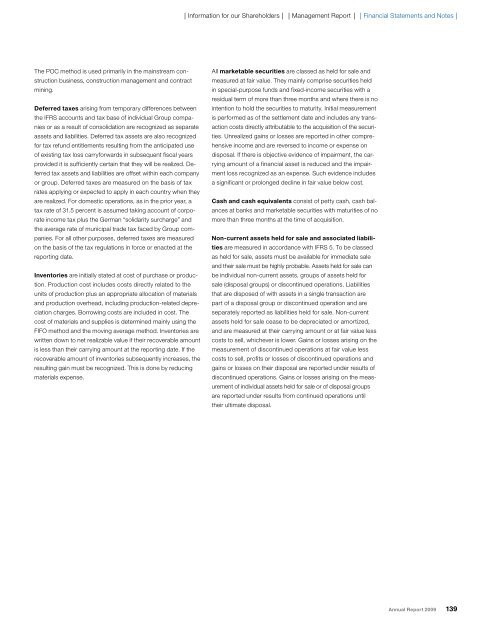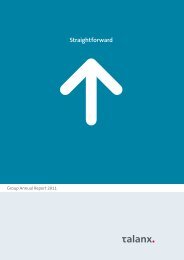ONE ROOF
ONE ROOF
ONE ROOF
Create successful ePaper yourself
Turn your PDF publications into a flip-book with our unique Google optimized e-Paper software.
The POC method is used primarily in the mainstream con-<br />
struction business, construction management and contract<br />
mining.<br />
Deferred taxes arising from temporary differences between<br />
the IFRS accounts and tax base of individual Group companies<br />
or as a result of consolidation are recognized as separate<br />
assets and liabilities. Deferred tax assets are also recognized<br />
for tax refund entitlements resulting from the anticipated use<br />
of existing tax loss carryforwards in subsequent fiscal years<br />
provided it is sufficiently certain that they will be realized. Deferred<br />
tax assets and liabilities are offset within each company<br />
or group. Deferred taxes are measured on the basis of tax<br />
rates applying or expected to apply in each country when they<br />
are realized. For domestic operations, as in the prior year, a<br />
tax rate of 31.5 percent is assumed taking account of corporate<br />
income tax plus the German “solidarity surcharge” and<br />
the average rate of municipal trade tax faced by Group companies.<br />
For all other purposes, deferred taxes are measured<br />
on the basis of the tax regulations in force or enacted at the<br />
reporting date.<br />
Inventories are initially stated at cost of purchase or produc-<br />
tion. Production cost includes costs directly related to the<br />
units of production plus an appropriate allocation of materials<br />
and production overhead, including production-related depreciation<br />
charges. Borrowing costs are included in cost. The<br />
cost of materials and supplies is determined mainly using the<br />
FIFO method and the moving average method. Inventories are<br />
written down to net realizable value if their recoverable amount<br />
is less than their carrying amount at the reporting date. If the<br />
recoverable amount of inventories subsequently increases, the<br />
resulting gain must be recognized. This is done by reducing<br />
materials expense.<br />
❘ Information for our Shareholders ❘ ❘ Management Report ❘ ❘ Financial Statements and Notes ❘<br />
All marketable securities are classed as held for sale and<br />
measured at fair value. They mainly comprise securities held<br />
in special-purpose funds and fixed-income securities with a<br />
residual term of more than three months and where there is no<br />
intention to hold the securities to maturity. Initial measurement<br />
is performed as of the settlement date and includes any transaction<br />
costs directly attributable to the acquisition of the securities.<br />
Unrealized gains or losses are reported in other comprehensive<br />
income and are reversed to income or expense on<br />
disposal. If there is objective evidence of impairment, the carrying<br />
amount of a financial asset is reduced and the impairment<br />
loss recognized as an expense. Such evidence includes<br />
a significant or prolonged decline in fair value below cost.<br />
Cash and cash equivalents consist of petty cash, cash bal-<br />
ances at banks and marketable securities with maturities of no<br />
more than three months at the time of acquisition.<br />
Non-current assets held for sale and associated liabili-<br />
ties are measured in accordance with IFRS 5. To be classed<br />
as held for sale, assets must be available for immediate sale<br />
and their sale must be highly probable. Assets held for sale can<br />
be individual non-current assets, groups of assets held for<br />
sale (disposal groups) or discontinued operations. Liabilities<br />
that are disposed of with assets in a single transaction are<br />
part of a disposal group or discontinued operation and are<br />
separately reported as liabilities held for sale. Non-current<br />
assets held for sale cease to be depreciated or amortized,<br />
and are measured at their carrying amount or at fair value less<br />
costs to sell, whichever is lower. Gains or losses arising on the<br />
measurement of discontinued operations at fair value less<br />
costs to sell, profits or losses of discontinued operations and<br />
gains or losses on their disposal are reported under results of<br />
discontinued operations. Gains or losses arising on the measurement<br />
of individual assets held for sale or of disposal groups<br />
are reported under results from continued operations until<br />
their ultimate disposal.<br />
Annual Report 2009 139
















